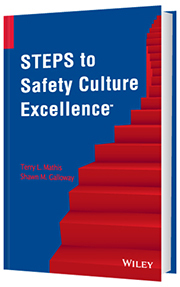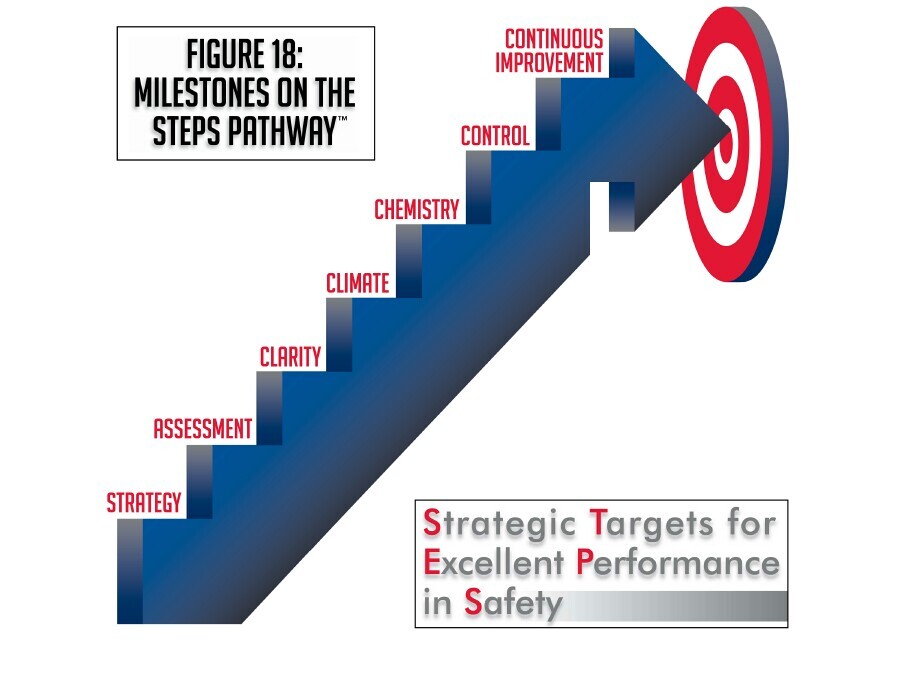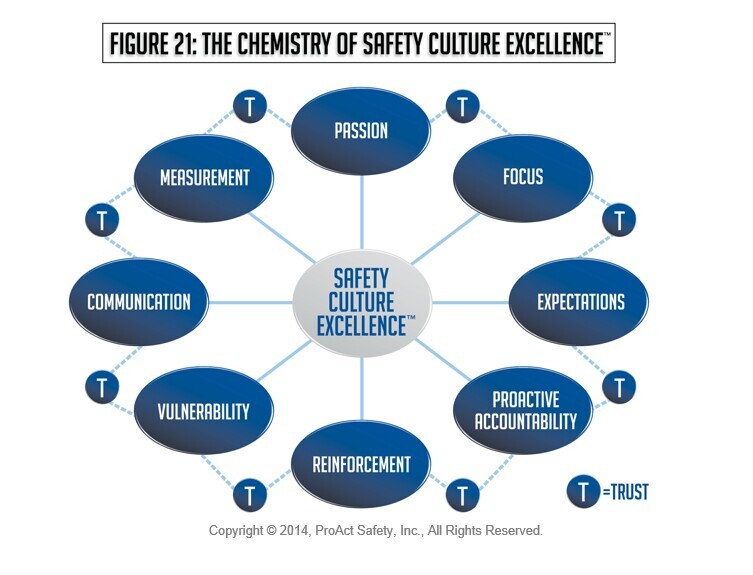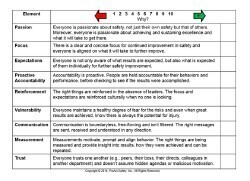Episodes

Monday Aug 18, 2014
350 - Evolving Your Safety Culture Elements That Matter Most
Monday Aug 18, 2014
Monday Aug 18, 2014
Greetings everyone, this podcast recorded while in Eunice, LA. I’d like to share an article I wrote that was published in the July 2014 edition of OH&S Magazine. The published article can either be found on the magazine’s website or under Insights at www.ProActSafety.com.
I hope you enjoy the podcast this week. If you would like to download or play on demand our other podcasts, please visit the ProAct Safety’s podcast website at: http://www.safetycultureexcellence.com. If you would like access to archived podcasts (older than 90 days – dating back to January 2008) please visit www.ProActSafety.com/Store. For more detailed strategies to achieve and sustain excellence in performance and culture, pick up a copy of our book, STEPS to Safety Culture Excellence - http://proactsafety.com/insights/steps-to-safety-culture-excellence
Have a great week!
Shawn M. Galloway
ProAct Safety

Tuesday Aug 12, 2014
STEPS to Safety Culture Excellence Workshop - October 2014
Tuesday Aug 12, 2014
Tuesday Aug 12, 2014

Based on the book, STEPS to Safety Culture Excellence, the authors will lead this workshop and provide a detailed roadmap on how to develop a three to five year safety excellence business plan. This two-day workshop is limited to ten participants. It would be helpful if each attendee read the book prior to the event to escalate the discovery process.

ProAct Safety® recently compiled data on over 1,100 sites that requested our help in improving safety. The commonalities of these sites' issues has led to a new approach to solving safety problems and permanently implementing continuous improvement. The approach includes organizational structure, problem identification, issue prioritization, action plan development, improvement metrics, and a motivational and marketing strategy to ensure sustainability. The process is called STEPS (Strategic Targets for Excellent Performance in SafetySM).
Objectives:
- Develop a solid understanding of a safety excellence strategy
- Learn the leading causes of safety program ineffectiveness and failure
- Examine a standard methodology used by excellent safety organizations to identify virtually any type of safety issue or problem
- Learn to use statistical tools to prioritize issues by their potential impact
- Learn to develop action plans to solve safety problems
- Explore innovative ways to measure success and progress
- Discover how one process can replace multiple programs and allow for seamless transition of focus without causing a flavor-of-the-month culture
Workshop Takeaways - Attendees will be provided with:
- Electronic Materials (Templates) to return to their organization and facilitate discussions for the creation of their unique safety excellence strategy.
- A 60-Minute Recorded High-Level Webinar outlining the key STEPS to Safety Culture Excellence methodologies. This will help convey the messages and build support and understanding for the necessary path forward. Moreover, this can also help during on-boarding of future leaders to provide an understanding of why the strategy was created, furthering the future support necessary as the organization continuously improves safety performance and culture and acquires or promotes new leadership talent.
- Access to Shawn M. Galloway or Terry L. Mathis from 8 am to 5 pm CT during the week by email and phone for one month following the workshop, to help support efforts by coaching and advising through the initial creation of the strategy. If not immediately available, calls and emails will be returned within 24 hours.
- A personalized autographed copy of the book, STEPS to Safety Culture Excellence.
For more information, visit this link.
See you there!
Shawn M. Galloway
ProAct Safety, Inc.

Thursday Aug 07, 2014
Upcoming Free Webinar: 3 Building Blocks For An Excellent Safety Culture
Thursday Aug 07, 2014
Thursday Aug 07, 2014
There is an increasing amount of talk about safety culture with very few real, implementable tactics that outline how to create a culture of safety excellence, and sustain it.
For the first time ever, leveraging the expertise of Canada’s Greg Ford of TalentClick and The United States’ Shawn M. Galloway of ProAct Safety, a free one-of-a-kind webinar will occur on the 24th of September, 2014.
This webinar will be a one a unique and revolutionary exploration into what both industry leaders (with different backgrounds, approaches and client experiences) have found to be the three most important building blocks of safety culture improvement. Safety culture has never been explored, developed, measured and understood like this before.
Greg Ford is the CEO of TalentClick Workforce Solutions. He is passionate about helping organizations eliminate incidents. He is committed to empowering people with “safety self-awareness” so they get home safely at the end of the day. Born in a blue-collar town and raised in a working-class family, Greg has a degree in Psychology and a Masters in Adult Education & Workplace Learning. He is CEO and co-founder of TalentClick and an adjunct professor at Simon Fraser University in Vancouver, Canada.
Greg’s articles have been published in numerous magazines and journals such as Workplace Today, Canadian HR Reporter, People Talk, Mining Weekly, Oil & Gas Monthly and others. He is a member of the Canadian Association of Professional Speakers and has spoken throughout North America.
Shawn M. Galloway is the President of ProAct Safety and coauthor of two books, his latest is STEPS to Safety Culture Excellence. He is one of the top speakers for American Society of Safety Engineers. National Safety Council calls him a “Global safety excellence expert” and a “Top-rated speaker” and listed him in the 2013 Top 40 Rising Stars.
He continues to be recognized by industry magazines as one of the most influential EHS leader and safety excellence expert. In addition to the books, hundreds of podcasts, articles and videos he is also the host of the highly acclaimed weekly podcast series, Safety Culture Excellence and a columnist for several magazines.
I hope you will join us for this exciting event!
Link to event: http://tinyurl.com/pu3axfn

Monday Aug 04, 2014
348 - A Transformational Pareto Analysis Finding Focus
Monday Aug 04, 2014
Monday Aug 04, 2014
Greetings everyone, this podcast recorded while in Orlando, FL. I’d like to share an article I wrote that was published in the July 2014 edition of Professional Safety Magazine. The published article can either be found on the magazine’s website or under Insights at www.ProActSafety.com.
I hope you enjoy the podcast this week. If you would like to download or play on demand our other podcasts, please visit the ProAct Safety’s podcast website at: http://www.safetycultureexcellence.com. If you would like access to archived podcasts (older than 90 days – dating back to January 2008) please visit www.ProActSafety.com/Store. For more detailed strategies to achieve and sustain excellence in performance and culture, pick up a copy of our book, STEPS to Safety Culture Excellence - http://proactsafety.com/insights/steps-to-safety-culture-excellence
Have a great week!
Shawn M. Galloway
ProAct Safety

Wednesday Jul 30, 2014
Transformational Leadership in Safety
Wednesday Jul 30, 2014
Wednesday Jul 30, 2014
Safety leaders are regularly looking for ways to improve safety, or are they? All too many leaders would settle for maintaining the status quo or managing to fail a little less this year than last. It is not that they would not like to make a truly transformational improvement in safety. They simply either don’t think it is possible or don’t have a plan to make it happen.
The beginning of a transformation in safety is to quit trying to control workers and start adding value to them. Workers may sometimes be the problem but they are also the solution. Helping workers perform more safely is different than controlling them. The whole terminology of “safety controls” loses its effectiveness when it moves from conditional controls to behavioral controls.
Transformation begins with winning hearts and minds over to safety excellence and providing the support to enable their efforts. Safety becomes a life ambition and not a game that needs rules to keep people from cheating. The hands and feet of workers only need to be controlled when their hearts and minds are not bought in and fully engaged in the safety effort.
-Terry L. Mathis
For more insights, visit www.ProActSafety.com
Terry L. Mathis is the founder and CEO of ProAct Safety, an international safety and performance excellence firm. He is known for his dynamic presentations in the fields of behavioral and cultural safety, leadership, and operational performance, and is a regular speaker at ASSE, NSC, and numerous company and industry conferences. EHS Today listed Terry as a Safety Guru in ‘The 50 People Who Most Influenced EHS in 2010, 2011 and 2012-2013. He has been a frequent contributor to industry magazines for over 15 years and is the coauthor of STEPS to Safety Culture Excellence, 2013, WILEY.

Wednesday Jul 23, 2014
Outsourcing Leadership Training
Wednesday Jul 23, 2014
Wednesday Jul 23, 2014
Today’s economic realities have necessitated a great deal of outsourcing. Organizations are clinging to their core competencies and value potential and hiring out peripheral tasks. In safety, more and more of the training function is being outsourced. This can be a good approach to some types of safety training but is definitely not for others.
Definite YES: Skills training by technical experts is almost always more effective. If the organization cannot justify keeping such an expert onboard full-time, outsourcing makes good sense and is often quite effective.
Definite NO: Training that establishes official management style or organizational philosophy. If you want your supervisors to coach safety or your leaders to stay on message about organizational mission and vision for safety, outside trainers are definitely not the way. Specific skills such as coaching or communications can be taught by outsiders, but the deep-rooted organizationally-specific style training is best done by an insider with recognized ties to the organization and specific information to answer questions on strategy and tactics.
Maybe with Qualifications: Training that is required for regulatory compliance can often be outsourced effectively. The one nuance is that much of this type of training is very generic and may not be easily or directly applied by workers to their specific tasks. Training that is too theoretical may lose its effectiveness if the link between the theory and workplace reality is not clear.
Outsourcing the right training and keeping the right training in-house can be a key to success in safety.
-Terry L. Mathis
For more insights, visit www.ProActSafety.com
Terry L. Mathis is the founder and CEO of ProAct Safety, an international safety and performance excellence firm. He is known for his dynamic presentations in the fields of behavioral and cultural safety, leadership, and operational performance, and is a regular speaker at ASSE, NSC, and numerous company and industry conferences. EHS Today listed Terry as a Safety Guru in ‘The 50 People Who Most Influenced EHS in 2010, 2011 and 2012-2013. He has been a frequent contributor to industry magazines for over 15 years and is the coauthor of STEPS to Safety Culture Excellence, 2013, WILEY.

Monday Jul 21, 2014
346 - Measuring Safety Culture Maturity A Better Way
Monday Jul 21, 2014
Monday Jul 21, 2014
This is an audio version of the previously published blog on this topic:
Forget the old ways of measuring safety culture maturity. There
is a new, more effective way to measure cultural maturity and it starts
with looking at the chemistry.

In consulting globally with many of the best in safety performance and culture, nine elements (see the picture with this post) have been identified as most important foci to establish the chemistry which facilitates the necessary climate for a culture of safety excellence to grow. Through consulting engagements and workshops, these nine elements have been successfully leveraged and measured to help organizations identify both their starting point baseline, and also to strategically prioritize which elements to focus on to advance the capabilities of their safety culture.

If you have read my work, participated in any of my workshops or keynote presentations or worked with me directly, you will know I work hard to always provide more take-away tools than motivational fluff. If I was able to provide the framework to facilitate the internal dialogue in article format, I would.
To assist you on your journey to safety excellence, I would like to share this tool with you. To obtain a copy for your internal use, send an email to info@proactsafety.com with the subject of Please Send Chemistry of SCE and our staff will respond at our earliest opportunity.
Cultures will always influence the beliefs and behaviors of employees and contractors as they join the group. You can either manage the chemistry, climate and culture, or the results in any area of operational performance will be managed by them. I invite you to start the conversation to strategically enhance the safety aspect of your company culture and measure your progress by contributed value, not just the lowering of injury rates.
-------------------
Shawn M. Galloway is the President and COO of ProAct Safety. He writes (and tweets:@safetyculture) about his work helping organizations in all industries to achieve and sustain excellence in their culture and performance. He resides near Houston, Texas with his wife and three children.

Wednesday Jul 16, 2014
Culture and Customizing
Wednesday Jul 16, 2014
Wednesday Jul 16, 2014
Some of the old safety programs and processes are still alive and well in certain organizations. When I examine how they have survived so long I almost always find that the program has been modified and customized. The organization is not still doing the process like they were taught, they have “made it their own” over the years using the basic concept(s) but modifying the details.
Another term for customizing might be “culturizing.” When a group of people not only use a methodology but modify it to fit their specific needs and standards, it truly becomes a part of the organizational culture. It is no longer solely the brainchild of the originator, but the adopted child of the group. As it permeates the group it becomes a part of the culture that is shared and handed down.
Such processes never become outdated because they are fluid and the group can evolve them to meet changing needs and challenges. Perhaps it should be the goal of every safety program or process to have this kind of flexibility built in as a sustainability tool. If this were the case, there would likely be fewer flavors of the month and more tools to build strong safety cultures.
-Terry L. Mathis
For more insights, visit www.ProActSafety.com
Terry L. Mathis is the founder and CEO of ProAct Safety, an international safety and performance excellence firm. He is known for his dynamic presentations in the fields of behavioral and cultural safety, leadership, and operational performance, and is a regular speaker at ASSE, NSC, and numerous company and industry conferences. EHS Today listed Terry as a Safety Guru in ‘The 50 People Who Most Influenced EHS in 2010, 2011 and 2012-2013. He has been a frequent contributor to industry magazines for over 15 years and is the coauthor of STEPS to Safety Culture Excellence, 2013, WILEY.

Monday Jul 14, 2014
345 - When Site Managers Undo Corporate Safety
Monday Jul 14, 2014
Monday Jul 14, 2014
Greetings everyone, this podcast recorded while in Banff, Alberta. I’d like to share an article Terry Mathis wrote that was published May 2014 in EHS Today Magazine. The published article can either be found on the magazine’s website or under Insights at www.ProActSafety.com.
I hope you enjoy the podcast this week. If you would like to download or play on demand our other podcasts, please visit the ProAct Safety’s podcast website at: http://www.safetycultureexcellence.com. If you would like access to archived podcasts (older than 90 days – dating back to January 2008) please visit www.ProActSafety.com/Store. For more detailed strategies to achieve and sustain excellence in performance and culture, pick up a copy of our book, STEPS to Safety Culture Excellence - http://proactsafety.com/insights/steps-to-safety-culture-excellence
Have a great week!
Shawn M. Galloway
ProAct Safety

Wednesday Jul 09, 2014
Measuring Safety Culture Maturity: A Better Way
Wednesday Jul 09, 2014
Wednesday Jul 09, 2014
Forget the old ways of measuring safety culture maturity. There is a new, more effective way to measure cultural maturity and it starts with looking at the chemistry.

In consulting globally with many of the best in safety performance and culture, nine elements (see the picture with this post) have been identified as most important foci to establish the chemistry which facilitates the necessary climate for a culture of safety excellence to grow. Through consulting engagements and workshops, these nine elements have been successfully leveraged and measured to help organizations identify both their starting point baseline, and also to strategically prioritize which elements to focus on to advance the capabilities of their safety culture.

If you have read my work, participated in any of my workshops or keynote presentations or worked with me directly, you will know I work hard to always provide more take-away tools than motivational fluff. If I was able to provide the framework to facilitate the internal dialogue in article format, I would.
To assist you on your journey to safety excellence, I would like to share this tool with you. To obtain a copy for your internal use, send an email to info@proactsafety.com with the subject of Please Send Chemistry of SCE and our staff will respond at our earliest opportunity.
Cultures will always influence the beliefs and behaviors of employees and contractors as they join the group. You can either manage the chemistry, climate and culture, or the results in any area of operational performance will be managed by them. I invite you to start the conversation to strategically enhance the safety aspect of your company culture and measure your progress by contributed value, not just the lowering of injury rates.
-------------------
Shawn M. Galloway is the President and COO of ProAct Safety. He writes (and tweets:@safetyculture) about his work helping organizations in all industries to achieve and sustain excellence in their culture and performance. He resides near Houston, Texas with his wife and three children.

